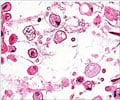Review the side-effects of Eliglustat as documented in medical literature. The term "side effects" refers to unintended effects that can occur as a result of taking the medication. In majority of the instances these side-effects are mild and easily tolerable, however sometimes they can be more severe and can be detrimental.
If the side effects are not tolerable adjusting the dosage or switching to a different medication can help to manage or overcome side effects. If you have any doubts or questions, we recommend seeking advice from your doctor or pharmacist. Gastrointestinal: Nausea, diarrhea, gastroesophageal reflux, dyspepsia (acidity), upper abdominal pain, constipation
Nervous system: Headache, migraine
Cardiovascular: Palpitations (noticeable rapid heartbeat)
Respiratory: Oropharyngeal pain
Skin: Rash
Others: Dizziness, pain in the limbs, back pain
Lab abnormalities: ECG changes should be monitored regularly.
Pregnancy may increase the existing Gaucher disease type 1 symptoms or result in new disease manifestations. But usage of eliglustat has been found to cause reduced fetal body weight, fetal brain and skeletal abnormalities in animals.
Caution is exercised while using eliglustat by breastfeeding women.
Patients with severe kidney damage are recommended not to take eliglustat.
Eliglustat is also not recommended in all stages of liver damage.
In case of over-dosage of eliglustat, patients may experience symptoms like dizziness, disequilibrium, hypotension, low heart rate, nausea, and vomiting.
The patient should be monitored properly and given symptomatic and supportive treatment. Hemodialysis is not beneficial as eliglustat has a large volume of distribution.
If the side effects are not tolerable adjusting the dosage or switching to a different medication can help to manage or overcome side effects. If you have any doubts or questions, we recommend seeking advice from your doctor or pharmacist. Gastrointestinal: Nausea, diarrhea, gastroesophageal reflux, dyspepsia (acidity), upper abdominal pain, constipation
Nervous system: Headache, migraine
Cardiovascular: Palpitations (noticeable rapid heartbeat)
Respiratory: Oropharyngeal pain
Skin: Rash
Others: Dizziness, pain in the limbs, back pain
Lab abnormalities: ECG changes should be monitored regularly.
Other Precautions :
Caution is needed while using eliglustat by pregnant women. It should be taken only if benefits are more than risks.Pregnancy may increase the existing Gaucher disease type 1 symptoms or result in new disease manifestations. But usage of eliglustat has been found to cause reduced fetal body weight, fetal brain and skeletal abnormalities in animals.
Caution is exercised while using eliglustat by breastfeeding women.
Patients with severe kidney damage are recommended not to take eliglustat.
Eliglustat is also not recommended in all stages of liver damage.
In case of over-dosage of eliglustat, patients may experience symptoms like dizziness, disequilibrium, hypotension, low heart rate, nausea, and vomiting.
The patient should be monitored properly and given symptomatic and supportive treatment. Hemodialysis is not beneficial as eliglustat has a large volume of distribution.





